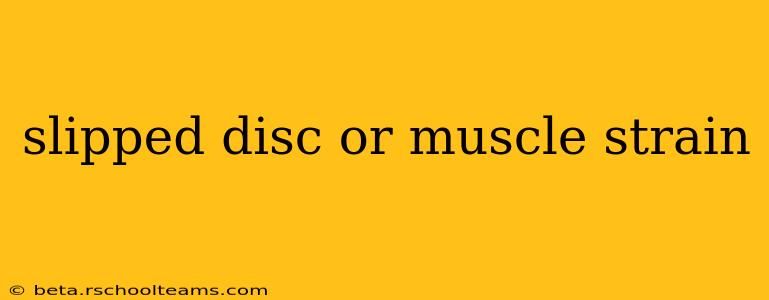Experiencing lower back pain? It's a common problem, and often the culprit is either a slipped disc or a muscle strain. While both cause similar symptoms, understanding the key differences is crucial for proper diagnosis and treatment. This comprehensive guide will delve into the nuances of each condition, helping you better understand your back pain and seek appropriate medical attention.
What is a Slipped Disc?
A "slipped disc," more accurately termed a herniated disc, occurs when the soft, gel-like center of an intervertebral disc pushes through a tear in the tougher outer layer. These discs act as cushions between the vertebrae in your spine. A herniation can put pressure on nearby nerves, causing pain, numbness, tingling, or weakness that radiates down your leg (sciatica). The location of the herniation determines the specific symptoms.
What causes a slipped disc?
Several factors contribute to slipped discs, including:
- Age: As we age, discs naturally lose hydration and become more prone to tears.
- Injury: Sudden trauma, like a fall or car accident, can cause a disc to herniate.
- Repetitive Strain: Repeated lifting, twisting, or bending can also contribute to disc damage.
- Genetics: A family history of back problems may increase your risk.
- Poor Posture: Maintaining poor posture puts undue stress on your spine.
- Obesity: Excess weight adds pressure to the discs.
What is a Muscle Strain?
A muscle strain, also known as a pulled muscle, occurs when a muscle or tendon in your back is overstretched or torn. This often results from sudden movements, overuse, or improper lifting techniques. The pain is typically localized to the affected muscle, although it can sometimes spread.
What causes a muscle strain?
Muscle strains are commonly caused by:
- Sudden movements: Jerking or twisting motions can easily strain back muscles.
- Overuse: Repetitive movements or prolonged exertion can fatigue muscles, making them more vulnerable to strains.
- Poor physical condition: Weak or inflexible muscles are more prone to injury.
- Improper lifting techniques: Lifting heavy objects incorrectly places significant strain on the back.
Slipped Disc vs. Muscle Strain: Key Differences
While both conditions cause back pain, there are some key distinctions:
| Feature | Slipped Disc | Muscle Strain |
|---|---|---|
| Pain Location | Often radiates down the leg (sciatica) | Typically localized to the affected muscle |
| Pain Severity | Can be severe, debilitating | Varies in severity, often less intense |
| Numbness/Tingling | Common | Less common |
| Weakness | Can cause weakness in the leg or foot | Less likely to cause significant weakness |
| Onset | Can be sudden or gradual | Usually sudden |
How are Slipped Discs and Muscle Strains Diagnosed?
A doctor will typically conduct a physical examination and review your medical history. Imaging tests, such as X-rays, MRIs, or CT scans, may be necessary to confirm the diagnosis. For muscle strains, a physical exam is often sufficient.
How are Slipped Discs and Muscle Strains Treated?
Treatment for both conditions varies depending on severity. Options include:
- Rest: Avoiding activities that aggravate pain is crucial.
- Ice and Heat: Applying ice initially can reduce swelling, followed by heat to soothe muscles.
- Over-the-counter Pain Relief: Medications like ibuprofen or acetaminophen can help manage pain and inflammation.
- Physical Therapy: Strengthening and stretching exercises help improve flexibility and stability.
- Medication: For severe pain, stronger pain relievers or muscle relaxants may be prescribed.
- Surgery: In rare cases of severe herniated discs that don't respond to other treatments, surgery may be necessary.
What are the long-term implications of a slipped disc or muscle strain?
Most slipped discs and muscle strains heal with conservative treatment within several weeks. However, some individuals may experience recurring episodes of back pain. Following a doctor's recommendations for treatment and rehabilitation is key to minimizing long-term complications.
Can a slipped disc heal on its own?
Many slipped discs heal naturally over time with conservative management. However, the healing process can take several weeks or months. Seeking medical attention is crucial to ensure proper diagnosis and to receive appropriate guidance and treatment.
Can a muscle strain heal on its own?
Minor muscle strains often heal on their own with rest and self-care measures. However, more severe strains may require medical attention and physical therapy.
How long does it take to recover from a slipped disc?
Recovery time from a slipped disc varies widely depending on the severity of the herniation and the individual's response to treatment. It can take anywhere from several weeks to several months.
How long does it take to recover from a muscle strain?
Recovery from a muscle strain typically takes a few days to a few weeks, depending on the severity of the strain. Proper rest and gentle stretching are essential for a speedy recovery.
This information is for general knowledge and does not constitute medical advice. Always consult with a healthcare professional for diagnosis and treatment of back pain. They can accurately determine the underlying cause of your pain and recommend the best course of action for your specific situation.
